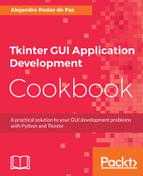There are a number of text conventions used throughout this book.
CodeInText: Indicates code words in text, database table names, folder names, filenames, file extensions, pathnames, dummy URLs, user input, and Twitter handles. Here is an example: "The delete() method takes two arguments that indicate the range of the characters that should be deleted."
A block of code is set as follows:
from tkinter import *
root = Tk()
btn = Button(root, text="Click me!")
btn.config(command=lambda: print("Hello, Tkinter!"))
btn.pack(padx=120, pady=30)
root.title("My Tkinter app")
root.mainloop()
When we wish to draw your attention to a particular part of a code block, the relevant lines or items are set in bold:
def show_caption(self, event):
caption = tk.Label(self, ...)
caption.place(in_=event.widget, x=event.x, y=event.y)
# ...
Bold: Indicates a new term, an important word, or words that you see onscreen. For example, words in menus or dialog boxes appear in the text like this. Here is an example: "The first will be labeled Choose file."
Warnings or important notes appear like this.
Tips and tricks appear like this.
